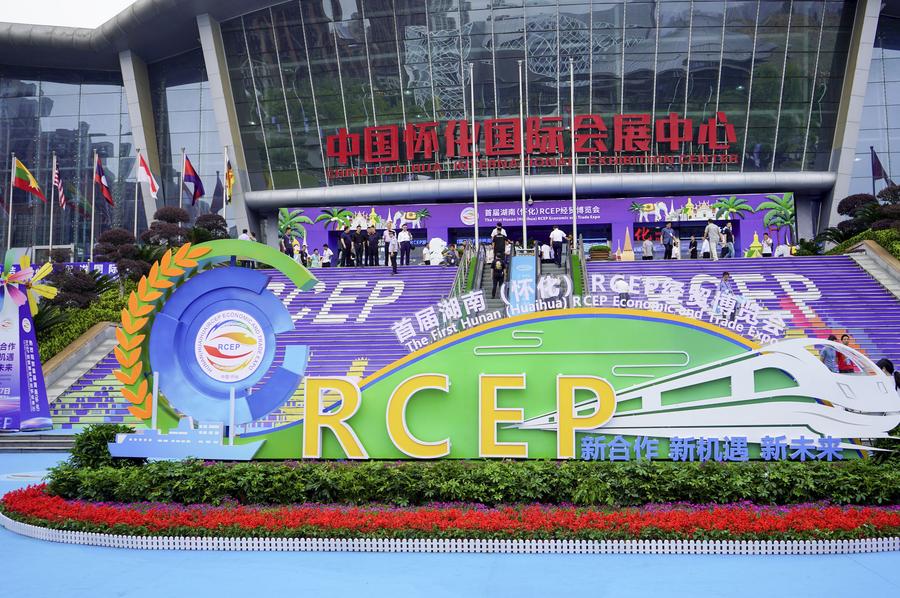China's foreign trade maintains momentum with fresh shifts
* China's record foreign trade data are "a testament to the resilience and adaptability of its economy," said Abdulaziz Alshaabani, a Saudi researcher at Al Riyadh Center for Political and Strategic Studies.
* Experts said China's stable foreign trade growth is due to its strong manufacturing capabilities, burgeoning consumer market, technological advancements as well as free trade policies, which create vast opportunities such as increased market access and enhanced supply chain integration for multinationals.
* EVs, solar batteries and lithium-ion batteries, categorized as China's tech-intensive and green "new three," reported a combined export value of 150 billion dollars in 2023, jumping 29.9 percent year on year.

People visit the booth of the United Arab Emirates during the 2023 China International Fair for Trade in Services (CIFTIS) at China National Convention Center in Beijing, capital of China, Sept. 4, 2023. [Xinhua/Wu Wei]
by Xinhua writers Wang Nan, Zhou Siyu
BEIJING -- China's foreign trade volume reached a new high in the first half of this year, showing strong resilience and a steady upward momentum despite the challenging external environment.
China's strong manufacturing capabilities, along with its burgeoning consumer market, technological advancements and favorable trade policies, have been providing its trade partners with vast opportunities and boosting the global economic recovery.
Observing a shift towards tech-intensive and green exports, as well as increased trade cooperation with emerging markets, overseas experts have expressed their confidence in the prospects of China's foreign trade.
SOUND MOMENTUM
China's trade volume expanded 6.1 percent year on year to about 2.97 trillion U.S. dollars in the January-June period, with exports rising 6.9 percent and imports climbing 5.2 percent, according to the country's General Administration of Customs (GAC).
It is the first time in the same period in history that the country's foreign trade exceeded 2.97 trillion dollars, said the GAC.
The growth of the country's foreign trade accelerated quarter by quarter, as it grew 7.4 percent compared to a year earlier in the second quarter, 2.5 percentage points higher than the first quarter and 5.7 percentage points higher than the fourth quarter of last year.

This photo taken on May 5, 2023 shows the venue for the First Hunan (Huaihua) RCEP Economic and Trade Expo in Huaihua City, central China's Hunan Province. [Xinhua/Yu Chunsheng]
China's record foreign trade data are "a testament to the resilience and adaptability of its economy," said Abdulaziz Alshaabani, a Saudi researcher at Al Riyadh Center for Political and Strategic Studies.
"This achievement highlights the country's effective handling of global supply chain challenges," said Alshaabani, adding it also underscores China's vital role in global trade and its ability to foster international economic partnerships.
China's global trading network is also expanding. The country has now become the world's largest trader of goods and a major trading partner for over 140 countries and regions, contributing an average of nearly 30 percent to the world's annual economic growth.
To date, China has signed free trade agreements with 29 countries and regions, according to its Ministry of Commerce.
GLOBAL SIGNIFICANCE
The rapid growth of China's foreign trade has not only accelerated its own economic development, but also made important contributions to the stability and recovery of the global economy.
"China's rapid foreign trade growth has significantly boosted the global economy by enhancing supply chain efficiency, increasing the availability of diverse goods, and stimulating economic activity worldwide," said Alshaabani.
Experts said China's stable foreign trade growth is due to its strong manufacturing capabilities, burgeoning consumer market, technological advancements as well as free trade policies, which create vast opportunities such as increased market access and enhanced supply chain integration for multinationals.
China has so far established 22 pilot free trade zones and is constructing the Hainan Free Trade Port. China has also created a number of international trade cooperation platforms like the China International Import Expo and the China International Fair for Trade in Services. Policies include shortening the negative list for foreign investment and lifting market access restrictions in such service sectors as telecommunications and medical care are introduced to encourage more foreign investment.

An aerial drone photo shows the Heihe Area of China (Heilongjiang) Pilot Free Trade Zone in Heihe, northeast China's Heilongjiang Province, Jan. 31, 2024. [Xinhua/Xie Jianfei]
"It has facilitated greater market access for international businesses and fostered economic interdependence, promoting global economic stability and growth," Alshaabani said.
"Additionally, China's robust trade activities help stabilize global supply chains, which is crucial for countries like Tanzania that are integrated into these networks," said Benjamin Mgana, chief editor of foreign news at The Guardian newspaper in Tanzania.
Amidst trade protectionism and anti-globalization sentiments, experts said China's active promotion of the Belt and Road cooperation, and multilateral platforms such as the Regional Comprehensive Economic Partnership (RCEP) facilitates smoother global trade flows and stimulates economic growth across participating countries.
The approaches help reduce trade barriers and foster global economic integration, said Mgana, noting "the BRI, in particular, has already led to significant infrastructure projects in Tanzania, enhancing its trade capabilities and economic growth prospects."
China's trade with countries participating in the Belt and Road Initiative (BRI) has maintained vibrant growth, with the trade volume up 7.2 percent to about 1.38 trillion dollars in the first six months of this year.
"Anti-globalization is doomed to failure and will benefit no one," said Franjo Maletic, professor at the University of the North in Croatia, adding China's growing foreign trade benefits many countries around the world, especially those that are less developed.
FRESH SHIFTS
While sustaining a steady growth, China's foreign trade has undergone fresh shifts, bringing new opportunities and trade drivers.
"China's exports are climbing the value chains, changing from exporting mainly labor-intensive goods such as apparel to high-tech products like electric vehicles (EVs)," Costantinos Bt. Costantinos, a professor of public policy at Addis Ababa University in Ethiopia, told Xinhua.
EVs, solar batteries and lithium-ion batteries, categorized as China's tech-intensive and green "new three," reported a combined export value of 150 billion dollars in 2023, jumping 29.9 percent year on year.
During the first half of this year, mechanical and electrical products continued to dominate China's exports, accounting for nearly 60 percent of the total.
China's investments, particular in advanced technology products, will continue, said Sant Manukyan, an analyst with Is Yatirim, the investment banking arm of Isbank Group in Istanbul.
He noted that a significant technological advancement is ongoing in China's foreign trade.

Visitors view a new energy vehicle during the 135th session of the China Import and Export Fair, also known as the Canton Fair, in Guangzhou, south China's Guangdong Province, April 15, 2024. [Xinhua/Liu Dawei]
China's push toward high-end manufacturing and new technologies especially in the green sector will have a positive spillover effect on its trading partners, said Lee Heng Guie, executive director of the Socio-Economic Research Center of the Associated Chinese Chambers of Commerce and Industry of Malaysia.
"The Ethiopian government has disclosed its plan to import 439,000 EVs in 10 years as part of an ongoing transition to electric mobility," Costantinos said, noting China can play a vital role in helping not only Ethiopia, but also the world to achieve a green transition and sustainable development goals.
Experts also observed that China's external demand structure is shifting from developed markets toward emerging markets.
While the demand from developed countries will likely decline, emerging economies including the Association of Southeast Asian Nations (ASEAN), Latin America and BRICS nations will be able to fill the gap, Yu Xiangrong, chief economist at Citigroup China said, noting that the country's export growth is expected to remain steady.
"China is now doing a lot of trade with the Global South in particular," said Horst Loechel, professor of economics at the Frankfurt School of Finance and Management, adding the growth in trade with these countries is important for the entire global economy.
"The development space for China's foreign trade is likely to expand with continued diversification into emerging markets and innovations in trade practices," Alshaabani said.
"China is expected to play a pivotal role in global economic development by driving innovation, enhancing international trade through initiatives like the BRI and RCEP, and contributing to global supply chains," the Saudi researcher said.
Video reporters: Wu Changwei, Nguon Sovan, Van Pov, Liu Yuxuan, Wang Lu, Chen Binjie, Huang Yan, Li Hanlin, Che Yunlong; Video editors: Liu Yutian, Liu Xiaorui, Zhang Yichi
























